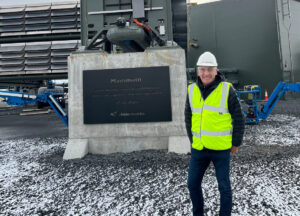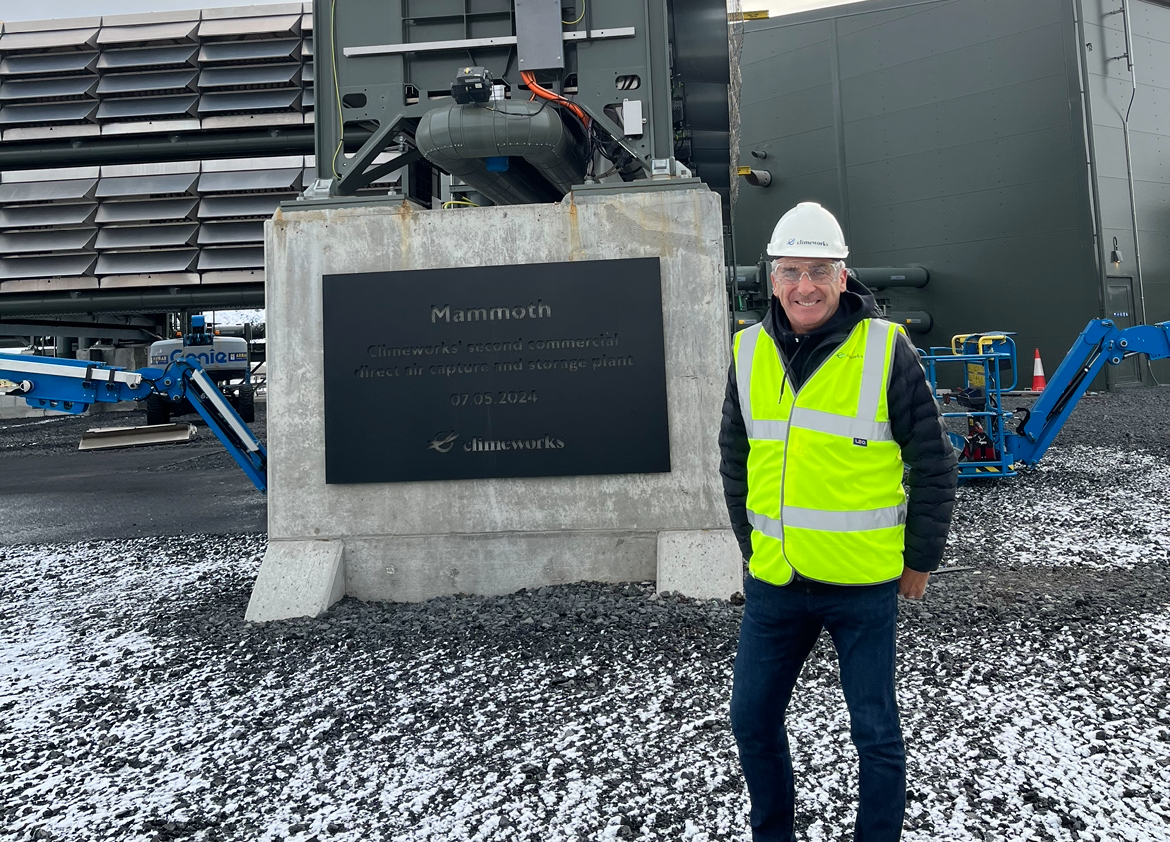Visiting Mammoth … the world’s largest carbon direct air capture and storage facility near Reykjavik in Iceland … operated by Swiss company Climeworks.
October 11, 2024

This week I got to visit the world’s largest carbon capture and storage facility in Iceland, operated by Swiss company Climeworks.
At Climeworks’ new “Mammoth” DAC facility, the CO₂ is permanently removed from the air by capturing and geologically storing it for thousands of years with Climeworks’ storage partner Carbfix.
The newly opened site is around 30km from Reykjavik, Iceland’s capital.
The ambition is certainly impressive. Approaching, I see the billowing steam of the huge On geothermal power plant, surrounded by a landscape of snow covered solidified lava, and distant volcanoes. Abundant geothermal energy is the main reason why Climeworks has come to Iceland.
And then I see the distinctive V-shaped suction “capture containers” of Mammoth. In some ways it looks like the world’s largest air conditioning unit, but its impact is exactly the opposite. These containers suck carbon dioxide out of the air, and filters it of its carbon in a heated chemical process.
Mammoth is the world’s largest carbon capture and storage plant, with over 200 engineers working there. It has a lifetime of around 25 years, and will be at full capacity by 2025 with 72 collector containers, and with a capture capacity of 36,000 tonnes.
Surrounding the Climeworks site are small white domes, where the captured carbon is pumped 700m underground, and mineralised into rock. They are operated by Climeworks’ local partner Carbfix, an Icelandic company that dissolves the carbon in water, then injects it into the basalt rock below.
Climeworks business model is to seek funding from business and individuals, who then fund the process. It has already sold a third of Mammoth’s lifetime capacity (to companies including Microsoft, JP Morgan, Stripe, BCG and PwC, plus individuals like Bill Gates, and the band Coldplay).
Climeworks empowers people and companies to fight global warming by offering carbon dioxide removal as a service via direct air capture (DAC) technology.
Climeworks was founded in 2009 by the mechanical engineers Jan Wurzbacher and Christoph Gebald. During their PhDs at the ETH Zurich, the two founders conducted research on direct air capture technology to remove carbon dioxide from the air. Based on that scientific research, Climeworks was founded as a spin-off from ETH Zurich, the 150 year old Swiss science and engineering university.
Climeworks is on a journey to deliver climate impact at scale. To do so, the company strives to inspire 1 billion people to act and remove CO₂ from the air. Since 2009 it has developed 15 DAC facilities around the world, including 6 locations in Switzerland, plus the UK, Germany, Austria and Belgium, operated by 500 “Climeworkers” .
Here’s how Climeworks works:
- Direct Air Capture (DAC): Climeworks employs direct air capture technology, which captures CO₂ directly from the atmosphere. Their modular and scalable DAC plants use air collectors to draw in carbon and trap it on specialized filters.
- Mammoth Facility: Their new Mammoth facility in Hellisheidi, Iceland, is a game-changer. It can capture 36,000 tons of CO₂ annually at peak capacity—about 10 times larger than their existing Orca plant.
- Patented Technology: Climeworks intends to capture a megaton of CO₂ by 2030 and an astounding gigaton by 2050 using their patented technology. This commitment is crucial for achieving net-zero emissions globally.
- Global Recognition: Carbon removal has transitioned from a niche concept to a globally recognized solution. The U.S. Department of Energy even awarded funding to Climeworks and its partners to build the country’s first large-scale direct air capture facilities.
- Underground Storage: Climeworks combines DAC with permanent underground storage (DAC+S). They inject the captured CO₂ deep underground, where it reacts with basalt rock, transforming into stone and remaining safely stored for over 10,000 years. This ensures it no longer contributes to global warming.
- International Expansion: While Iceland offers ideal conditions, Climeworks is expanding globally. They’re exploring projects in the U.S., Canada, Norway, and Kenya to remove CO₂ on a megaton and gigaton scale.
By actively removing CO₂, Climeworks plays a vital role in our fight against climate change.
A few photos from my recent visit to the Icelandic site …
Approach the site, the nearby On geothermal power station provides huge amounts of clean, free energy to power the DAC process:
Climeworks’ new Mammoth plant is far larger than its initial Orca test facility, and is distinctive for its V shaped wings:

Up closer, the vents open, sucking carbon dioxide from the air, recognising the challenge is not just to reduce emissions but to clean up historic emissions:

Iceland was chosen as the location for the Swiss company’s plant as it is not only an excellent source of geothermal energy, but also to store the carbon underground, in partnership with Carbfix:

The “Mammoth” DAC facility, is currently the largest in the world, and was opened in April 2024, and now in full production:

Thank you to Climeworks, and the University of St Gallen, for enabling such a rare and fascinating insight into the frontiers of fighting climate change, and creating a cleaner future.
More from the blog
